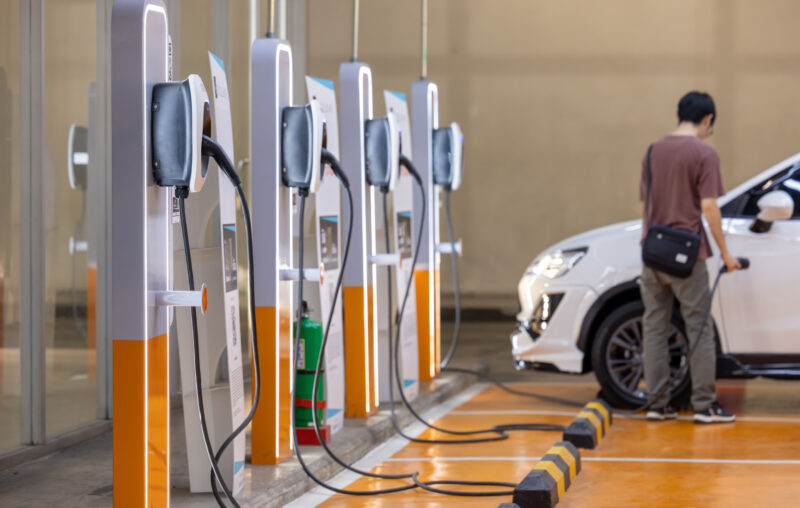Let the Market, Not Government, Decide the Fate of EVs

Advocates of various energy technologies have long argued that major barriers, either government or market-derived, stifle the development of their favored technology. They then infer that the current level of their preferred technology is suboptimal, necessitating some form of governmental intervention.
That seems to hold true for New Mexico Governor Michelle Lujan Grisham, who wants state tax credits and mandates on the purchases of electric vehicles (EVs). On November 16, the Governor’s appointed Environmental Improvement Board adopted a stringent clean car rule that requires 82 percent of all new vehicles delivered to the state to be zero-emission by 2032.
The Governor’s agenda is a double whammy for gasoline/diesel-powered vehicles: make EVs more economically attractive with taxpayer-funded subsidies and restrict the number of gasoline/diesel-powered vehicles that New Mexicans can buy.
Perhaps the strangest part of her agenda is that she hopes to trim the number of gasoline/diesel-powered vehicles in the state without knowing whether that is what the citizens of New Mexico want. Car owners are, after all, wary of EVs for various reasons, including high upfront costs, limited range, and people’s inherent skepticism of new technologies.
She is telling New Mexicans that she knows better what types of vehicles they should purchase than they do, ignoring the wishes of her constituents in the process. Today only about 1 percent of the vehicles in New Mexico are EVs.
The Governor is looking to fundamentally reshape the car industry via regulations, mandates, and subsidies. Added to the insult is her requirement that taxpayers pay for her “all-electric” scheme when utmost of them don’t stand to benefit.
So far, purchasers of EVs are mostly in the high-income category, and that will likely hold for the foreseeable future. What that means is that tax credits and other subsidies will benefit the well-to-do, and will be paid for by people who are less financially well-off. One study noted that “The US academic literature indicates that up to 90 percent of EV purchase incentives adopted by the federal government have flowed to the richest one-fifth of households.” This also suggests that many of the purchasers would have bought an EV in the absence of government incentives. This behavior means that the reduction in greenhouse gas (GHG) emissions attributable to the incentives is overstated, and that the incentive is essentially a windfall gain to higher-income households paid for by the less well-off.
A mandate to require that a certain percentage of vehicles are EVs represents a policy with intrinsic distortions. It is a blunt instrument, draconian and expensive relative to other ways of mitigating GHG emissions (which is the stated rationale for the governor’s all-electric mandate).
Banning or artificially restricting goods or services dictates consumers find a substitute that they think is inferior to the product being banned, or else such action would not be necessary. A ban forces consumers to do something that they otherwise would not do. By reducing options for vehicle owners, driving will become more expensive in New Mexico.
Government controls over GHG emissions directly affect goods and services, such as electricity and transportation, whose costs will likely escalate. If controls include banning or severely restricting fossil fuels like gasoline, the costs could be substantial. We have an abundance of fossil fuels at affordable prices, which explains why over 80 percent of the world’s energy still comes from fossil fuels. This raises the question of whether we want to, or even can wean ourselves from fossil fuels over the next two or three decades without suffering severe economic consequences.
The governor’s actions presume that EVs are a winning technology – but this is presumptuous, as there is much uncertainty over the future of EVs. Mandates carry risks. Mandates require policymakers to pick winners and losers, an almost impossible task, and often results in failure given the limited knowledge of policymakers and their propensity to serve special interests. The problem is particularly acute for new technologies with a high level of uncertainty over cost and performance. A better way to make EVs more attractive to consumers is to have them compete against gasoline/diesel-powered vehicles. When regulating or legislating away their main competition, it becomes more likely that EVs will continue to be inferior to gasoline/diesel-powered vehicles.
What is particularly perplexing is the rationale behind the Governor’s intent to accelerate the purchase of EVs by New Mexicans through tax credits and mandates. She argues that the tax credits will make EVs more affordable to middle- and low-income households. But one cannot ignore the evidence showing that the subsidies will disproportionately benefit the wealthy at the expense of the less well-off. So far, 90 percent of EVs in the US have been purchased as a second or third car by high-income households.
It’s not even clear that replacing gasoline/diesel-powered vehicles with EVs will have a positive environmental effect. Similar to many other batteries, the lithium-ion cells that power most electric vehicles rely on raw materials (like cobalt, lithium, and rare earth elements) that have triggered grave environmental and human rights concerns. Cobalt has been especially problematic. The environmental effect, of course, also depends on what energy sources are used to produce electricity. Currently, much of the electricity generated at night (when charging occurs for most EVs) comes from fossil fuels.
Even if EVs lower GHG emissions, studies have shown that they are inefficient in terms of the cost per unit of avoided emissions. Other alternatives, such as nuclear power and natural gas are more cost-effective. One study found that EVs are among the most expensive tools government can use to lower GHG emissions, as measured by dollars spent to achieve a given amount of GHG reduction. A better policy would be to impose an efficient tax on GHG and tailpipe emissions.
Indeed, most climate activists view fossil fuels as a barrier to achieving deep-decarbonization targets deemed essential to protect against alleged catastrophic climate change. They consider the electrification of buildings and transportation with clean-energy sources as part of a policy portfolio to achieve these targets. What they don’t say is that their proposals for government intervention will have benefits less than costs, and is in fact a subsidy for the rich.
EVs are a remarkable technology that I hope will succeed without government assistance. Both for equity and economic efficiency, government inducements, whether to hasten the number of EVs or charging stations are a bad idea. Governments can better spend taxpayers’ monies. EVs have a promising future. Technological advancements in batteries, other aspects of production, and charging stations will determine consumers’ demand for EVs and manufacturers’ profits from EVs, ultimately deciding the fate of the product. Their success is more likely if government steps out of the way and allows EV providers to address market demands to lure consumers with price reductions and better vehicle performance —not with subsidies and mandates.











